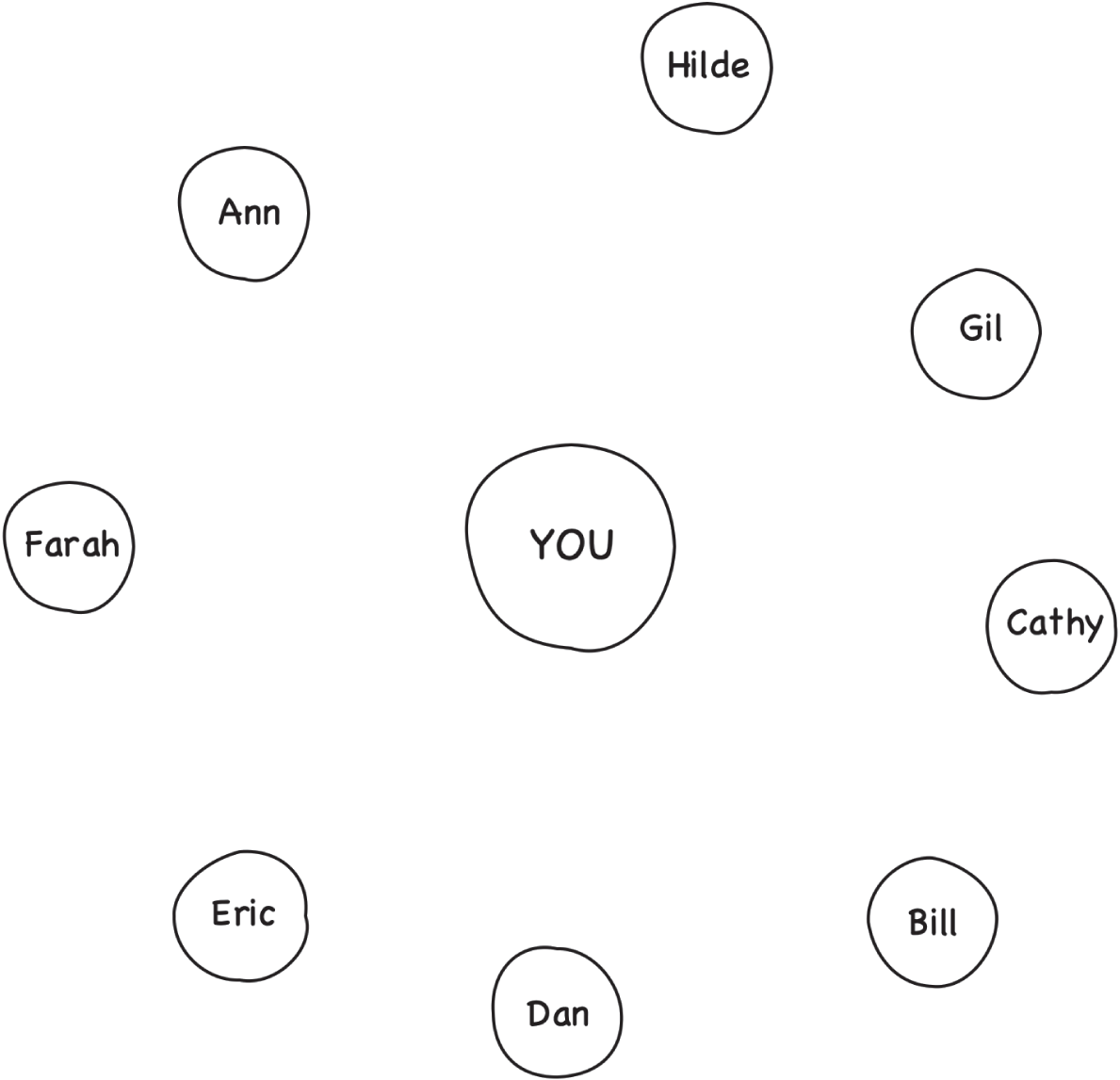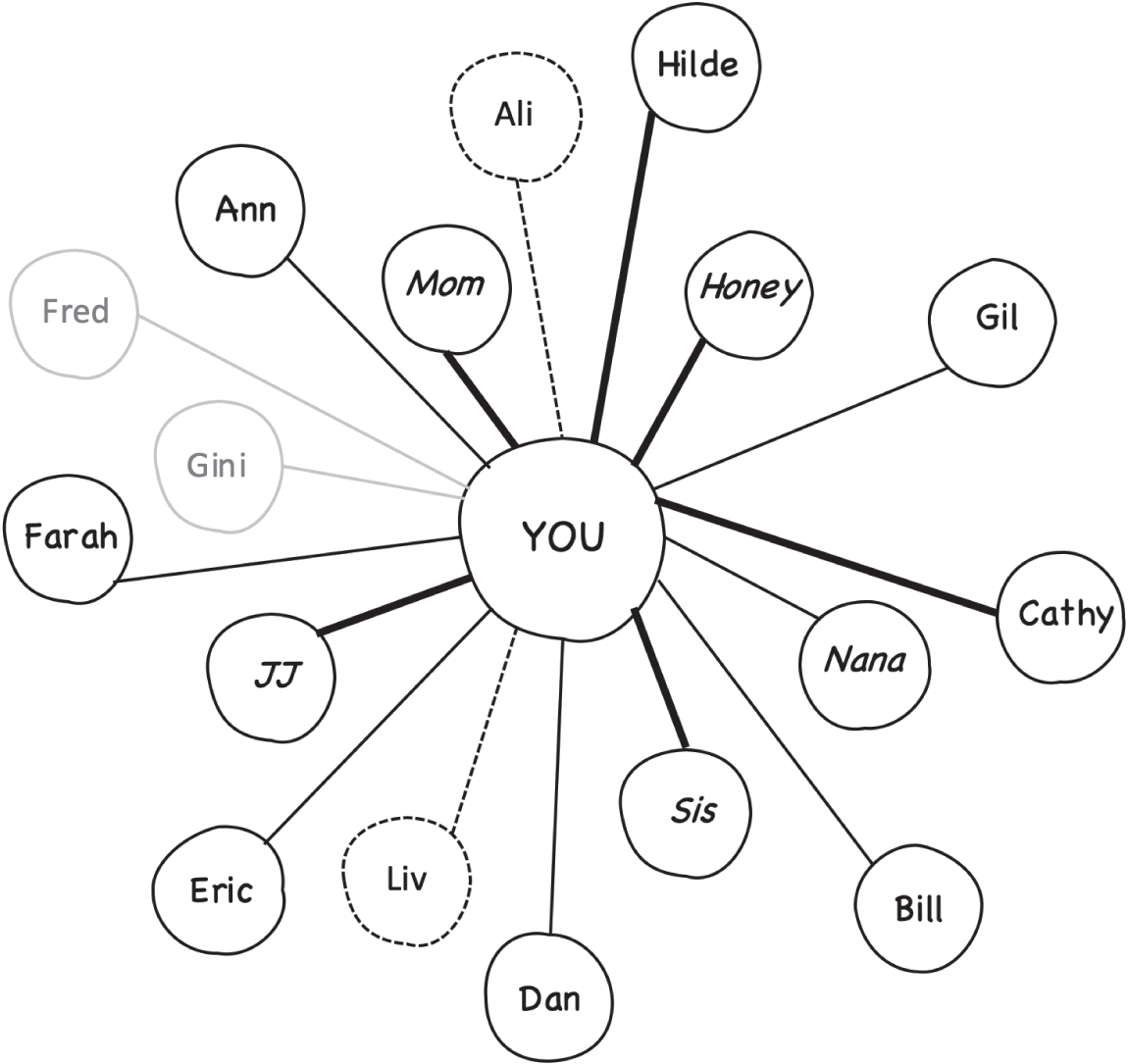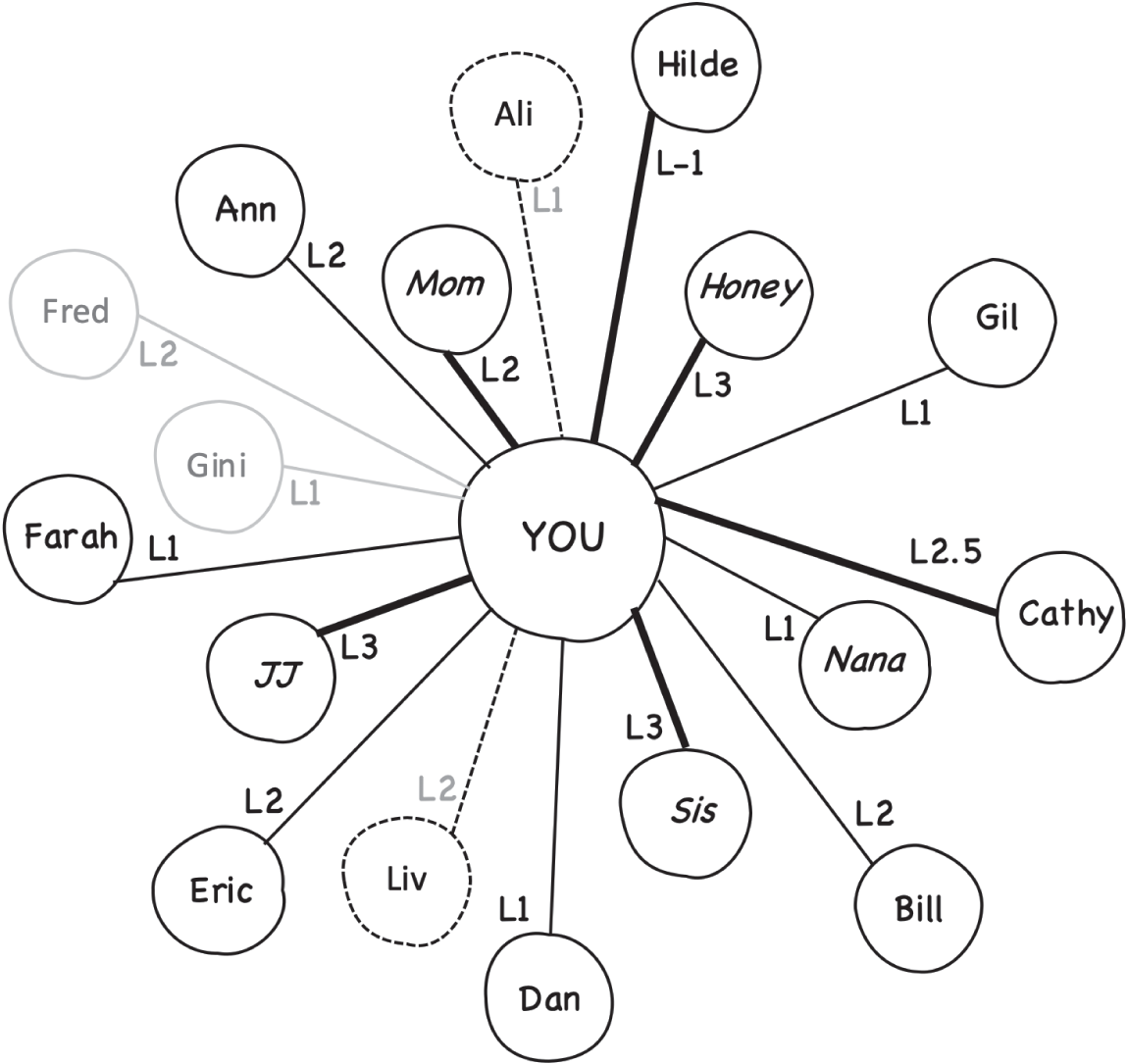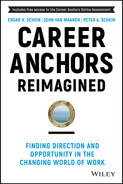2
Building a Relationship Map
Dr. Seuss:
“… Somehow you'll escape
all that waiting and staying.
You'll find the bright places
where Boom Bands are playing …”
Because of pandemic “stay at home” and “lockdowns,” how, where, and with whom we work on a daily basis is still changing. Many of us have (a) learned to work from home, (b) have had to interrupt our work for unanticipated durations, (c) have left or lost our pre‐pandemic jobs, and/or (d) are considering a new line of work altogether.
These changes in work lives will inevitably affect relationships in our family and with our informal lives with friends and colleagues and the “boom bands” that help us through the tough times.
Many of you will face the following questions
- What kind of work will you do?
- Where will you work?
- How much will you work?
- With whom will you work?
- What kind of relationships will you have at work, in your family, and with friends?
Before you tackle the career aspiration issues in the first three questions, it seems inevitable that some old relationships will have to be reestablished, some new relationships will have to be created, and adaptations will have to be made in the balance of work, family, and personal pursuits. This will be true in how you relate to colleagues, the people above you and below you, and the people with whom you share tasks and objectives, whether in person or in virtual office settings.
We now provide you an opportunity to examine those relationships so as to visualize whether you need to make new choices in how you manage relationships and career directions. When you have gained some insight into your “map” you will then be able to relate those relationships to the new map of work and career options that build on the career anchors exercise.
We suggest you start with mapping relationships because we believe that as you look ahead you will be driven more by multidimensional life‐work considerations that are broader than just career anchors. To this end, the following exercise consists of several parts, which together may take up to an hour or so.
You will draw relationship maps that consist of the various people to whom you are connected. You will then read about different “levels” of connection or relationship and fill those in. You will then reflect on these relationships in order to decide what level you desire in them as you look ahead in this VUCAA world.
Building the Basic Relationship Map
In the first exhibit (Exhibit 2.1) below you'll find a blank version of what we call a “relationship map.”
A “relationship” exists if you and the other person each have some expectation of how the other person will respond as you are interacting with each other. A relationship is by definition mutual. Each of you expects something of the other even if you do not interact with that other person on a regular basis. Each of you has some kind of impact or influence on the other.
Your relationships organize most of the behavior of your daily life, so it is important to see their impact on you and your impact on others.

Exhibit 2.1 Relationship Map Initial Template
Step 1: Circles as building blocks
Start with a blank sheet of paper (we would suggest 8 ½ by 11 or A4 to give you ample room to draw your relationship circles). Draw yourself in a circle in the approximate center of the page, and draw any number of blank circles surrounding yourself.
Step 2: Circles for work relationships
The blank circles are used to represent the key people with whom you work. Write their names in the circles that are arranged around you (Exhibit 2.2). Consider leaving plenty of room to add circles for other key relationships that come to mind as you go through this process.

Exhibit 2.2 Filling in Work Relationships
You can use the location of the circles to signal status or hierarchy by putting the people whom you think of as above you, beside you, or below you in the circles that are in those positions.
Step 3: Circles for family and personal
Draw more circles representing key family and personal relationships that affect your work and personal life (Exhibit 2.3). Children and a partner or spouse can absolutely be included. Any other relatives can be included if they influence your work and personal lives.
The goal is to identify the particular people in your life who have an influence on you, who have expectations of you, and whom you would normally describe as being connected to you, that is, relationships that affect you on a daily basis. (Feel free to add extra pages or use a larger template [poster size] if you want to widen the map even further.)
Step 4: Circles for lost or future relationships
You should include in this map not only your current active relationships but also draw circles for relationships that you lost or have become more distant because of the pandemic or for other reasons. Add relationships that you have gained or believe you will gain as you look ahead (Exhibit 2.4).
You may discover that you have many relationships in your life and that these have been affected in various degrees by any number of events of the last decade or two. You have work relationships, family relationships, friendships, and community relationships. For purposes of this exercise put as many of them on your map as needed to help you gain a complete picture of the interpersonal network in which you live, using extra pages if necessary to make the whole picture clear to yourself.

Exhibit 2.3 Filling in Personal Relationships
Visualizing as much of the network as possible on this simple hand‐drawn map(s) may be critically important in illuminating how external and internal forces have affected all those connections in a variety of ways, with your work relationships most likely feeling the brunt of the impact.

Exhibit 2.4 Emerging or Changing Relationships
Step 5: Drawing lines to identify relationships
You can now draw lines to these various relational circles to express the intensity of the different relationships you have identified (Exhibit 2.5).
Draw heavy solid lines where the relationship is steady and frequent, and draw broken or dotted lines where there is a relationship but it is not as strong, using for now just your intuition of what it means to have a strong, weak, or distant relationship. Next, we will give you some categories for analyzing levels of relationships that will enable you to be more precise about the lines you have drawn.
Keep an open mind and take your time to include all the important people with whom you feel you have a relationship. If you are doing this exercise with someone else, then each of you should do it and compare your maps to see whether either of you have left out some important categories of relationships such as people who are not physically present at work or at home but have an impact on your work and home lives.
One important thing to note—it is tempting to include circles for functions, divisions, or roles that you interact with. As a first step, that is fine. However, the primary intent of this exercise is to focus on the relationships with a particular person.
This exercise is about the people, not the roles. If you have put a placeholder circle for a role (for instance, “legal” or “accounts payable” or “HR”), take a moment and identify that person who you spend the most time with or expect to spend the most time with. You are trying to move beyond the simpler notion of role relations and deepen your thinking about the whole person to whole person relationships.

Exhibit 2.5 Depth of Relationships (using variable lines)
At this point, take some time to reflect and think about what it means to have good or bad relationships and weak or strong relationships. Then familiarize yourself with our model of “Four Levels of Relationship” described in the next section. When you finish, we will ask you to consider: (1) the level of relationship you have with the various people you named, and (2) the level of relationship you think you should have with them as you look ahead and consider various kinds of work situations that you may find yourself in.
Four Levels of Relationship
We intuitively sense that we have a very strong relationship with some people or a very weak relationship with others. Some relationships feel good and others not so good. We feel more connected with some people than with others, and we may feel that relationships at work seem quite different than the relationships at home. Similarly, relationships we have with friends are different from those at work and at home, even though there is often an overlap as we think of friends at work and our spouses or partners as our best friends.
Our relationships at home differ according to whether we are talking about our spouse or partner, our children, our parents, our in‐laws, or other relations such as cousins and nephews, grandchildren, and so on. Or cultures have trained us in how we are supposed to relate to these various categories but also allow us a great deal of freedom, which results in having better or worse relationships with different relatives.
To make sense of all this so that we can be proactive with our relationships, we need a model or taxonomy. We are not inventing this model, we are applying some labels to levels of relationship that are generally recognized in most societies. How each of these levels will play out in the particular culture in which you live will depend, and should depend, on your particular socialization or learning. These levels should not feel limiting any more than a wireframe or foundation only provides the broad outlines into which you fill in the details that fit your particular situation.
- Level −1: Domination/Coercion through power
- Level 1: Transactional Relationships based on role behavior
- Level 2: Personal and “Personized” Relationships
- Level 3 Emotionally Intimate Relationships
Level −1: Domination and Coercion: This level is characterized by a dramatic disparity between the side with power and the side with essentially no power. We label these “minus one” because we are describing a relationship, yet it is a negative relationship; level zero would imply no relationship. Examples here could include managers in a coercive organization or shop floor bosses in a sweat shop.
We would use Level minus 1 to describe prisoners, POWs, and even slaves relative to the guards or “masters.” There are even times that we dominate friends or acquaintances or members of divergent cultures or ones we consider lower or inferior. There are times we may relate to people much younger and less experienced, or older and less facile, in a domineering way that we would have to admit is Level minus 1, domination or coercion.
These relationships are usually less comfortable for the dominated person, but if one is required to remain subordinate, it is sometimes even possible to adapt to and tolerate the lower role. And there is a time dimension—there are relationships that are intended to be Level minus 1 to begin with, as a tough form of inculcation or indoctrination and which will then use the experience of this disparity of power to strengthen the bonds as the relationships develop. In the armed forces, Level minus 1 bootcamp may well have the effect of reinforcing stronger bonds later on, as a tough ordeal shared by those who have made it through. The same might be true of tough training and inculcation experiences such as medical school and medical residency.
Step 5A
Now, go back to your relationship map that you drew in Step 5 (Exhibit 2.5) and put a minus 1 (−1) next to any lines that you consider to be Dominating or Coercive.
Level 1: Transactional Relationships based on role behavior: These are common daily relationships that we have in casual conversation with strangers on the street or seatmates on public transportation. These relationships are almost always scripted by the roles we have learned and implicitly agree upon when we go to stores, restaurants, banks, or deal with service people whose help we need, including professional helpers of all sorts (such as a plumber, a mechanic, and even a doctor or lawyer).
We treat each other as fellow humans whom we trust enough to not harm us and with whom we have polite levels of openness in conversation, but we do not feel the need to know each other except in our various roles and statuses. Professional helpers such as doctors and lawyers fall into this category because their role definition requires them to maintain relational decorum or “professional distance.”
This level often includes fellow employees, bosses, and direct reports with whom we interact in terms defined by our official roles or ranks. Whether or not we trust them and are open with them depends on the situation—transactional relationships in work groups can be open and collaborative but are more likely to be defined as competitive situations, especially with colleagues, who are ultimately competing with us for the same promotions or other incentives for good performance.
In our various commercial dealings, we typically expect transactional relationships to be zero‐sum or “my gain is your loss” and hope to walk away from them with a feeling of having gotten “a good deal.” We maintain professional distance and expect ourselves and our counterparts to be equally distant.
These relationships can be felt as good or bad within the tight bounds of a hierarchy, and personal connection is inevitably constrained since we are typically talking about requisite transactions between competitors. We should not hide from the reality that our modern Western capitalist system relies on this basic organizational principle of competing for promotion, for which Level 1 transactional relationships seem perfectly suited.
The most important point to be noted about Level 1 role‐based transactional relationships is that they can lend themselves to exploitation and destructive competitive behavior.
Step 5B
Now, again go back to your relationship map (Step 5, Exhibit 2.5) and identify and label all of the Level 1 relationships.
Level 2: Personal and “Personized” Relationships: These relationships reflect that we see the whole person, above and beyond their role or status, such as in our friendships. We can describe these connections as personal but not necessarily intimate.
Such relationships may begin at a transactional level but evolve through mutual curiosity and interest into deeper relationships by way of “personization.” This is a process of mutually connecting with each other as whole people, suspending concerns about role and status, by asking each other more personal questions and revealing more of ourselves to the other person.
This kind of relationship implies a deeper level of trust and openness in terms of (1) making and honoring commitments and promises to each other, (2) agreeing to not harm each other or undermine what we have agreed to do, and (3) agreeing not to lie to each other or withhold information relevant to our various tasks and obligations.
Step 5C
You may not have thought of this as applying to the work situation, yet you can identify on your map those links that are clearly more collaborative, more open, and more trusting. Mark them as Level 2 on your relationship map.
Level 3: Emotionally Intimate Relationships: These are relationships where stronger positive emotions and intimate contact may be involved. As such, these connections are often considered taboo in organizations and work settings. Trust here goes beyond Level 2 in that the participants not only agree not to harm each other but assume that they will actively support each other, with particular bias, whenever possible or when needed. The openness between two people at Level 3 develops to the point of sync or telepathy that much of the other's reactions and state of mind can be anticipated. Simply put, Level 3 means you can finish each other's sentences.
A form of Level 3 relationships can evolve in groups and teams when the work is highly interdependent and every outcome, every step of the way, is mission critical. Such degrees of high expectation of success (possibly even life or death) require that these teams or groups spend disproportionate amounts of time together (as in every waking hour).
A kind of “professional intimacy” may develop in work situations that we would describe as Level 3, or perhaps more accurately Level 2.5. Examples here can include high‐performance teams in the military (e.g. Special Forces such as Navy SEALs), in professional sports teams, or start‐ups that exert their drive to succeed in the 2x normal work week commitments expected of key employees and founders. In these high commitment and highly interactive contexts, Level 2.5 is a likely and hopefully positive by‐product of the time spent together.
Step 5D
Now, lastly, return to your relationship maps and fill in those links that have reached this level by putting a 3 (or 2.5) next to them.
Assigning levels to each relationship is done by progressively adding numbers to the map. If your relationship map is complete with all lines—intense as well as distant or broken—and marked appropriately, your map may look something like the representation in Exhibit 2.6.

Exhibit 2.6 Mapping Levels of Relationship
Gaining Insight into Your Relationships
The purpose of doing this is to gain some insight into how your various relationships differ in level because we believe that the pandemic, perhaps even the last decade as a whole, has had an impact on work and home relationships and can be captured visually by mapping relationship changes over time.
You should feel free to create multiple maps if you prefer to differentiate social categories of relationship such as just work relationships, just family relationships, and any other categories that you feel will be important in how you plan your future. If you have drawn your map on new sheets of paper, add pages and plan to keep these notes for future reference.
You may also wish to elaborate this exercise by also showing where you think a relationship has changed from the past to the present by using numbers and arrows between them for each line to depict past, present, and desired future relationships.
In Exhibit 2.7, our hypothetical subject, the “you” in the exhibits, has updated her map to capture the change from the departure of some colleagues in her work life and the new relationships that should now feature prominently on her map.
Also note that she has updated her relationship with Hilde, her boss. This is a visualization of her intent, or the result of her making a conscious effort, to draw closer to an otherwise domineering manager and forge a deeper bond based on mutual openness and building mutual trust.

Exhibit 2.7 Changing Relationships and Levels
We recommend that you do this exercise carefully at first and be ready to redo the map or maps frequently—the visualization can really help sort out complex relationship dynamics in your life‐work balance. We hope relation‐ship maps will prove to be an important guide not only for the here and now but also as you think your way into the future and want to come back to these maps from time to time as you process new experiences. Visualizing the present and gauging future progress are both helpful outcomes of this exercise.
Why All This Relationship Stuff?
We have taken you through a multifaceted exercise on the nature and levels of relationships because we believe that it is relationships that have changed and evolved most in the last decade. We also believe that those relationship changes have had a major impact on what we work on, where we work, with whom we work, and how “personized” our work will be as we look ahead.
Perhaps the most important question pertaining to future work is whether we want to work closely with people and develop personized relationships at work or are we satisfied with the professionally distant relationships that so much of our office work has become and/or that working from home engenders.
How does the quality of relationships have a direct impact on communication and, thereby, on the quality of our work? We hear about the importance of psychological safety, learning to speak up, more transparency and openness, and the need for more employee engagement in the workplace. All of this implies significant cultural changes in the relationship dimensions of how work gets done in the age of VUCAA.
This exercise is essential if you are to accurately assess your own work needs and anchors, as well as the kinds of organizations you will consider joining. What demands will you make on your supervisors and managers, what kind of culture will they have grown into, and what will their demands be of you?
If you are already or will be a manager, what will you expect of your direct reports and what will they expect of you? If you are to report to a general manager, what do you expect of him or her? We have encountered numerous examples in the next generation of employees expecting to be related to at Level 2, as whole human beings, and finding themselves in professionally distant Level 1 or sometimes even in Level −1 work relationships. It is commonly found that people leave jobs primarily because of a bad boss, and we think that this feeling is most likely the result of being treated transactionally (Level 1) as just a role instead of being seen as a whole person (Level 2).
In summary, you need to be honest with yourself about what you expect in your work, what you will settle for, and how you will know what is going on in your place of work. We believe your various relationship maps will help you do that.
